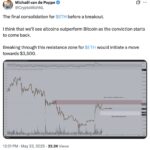In the ever-fluctuating world of cryptocurrency, a stark reminder appeared as traders faced the impact of geopolitical tensions on their investments. Recent statements from former President Donald Trump regarding significant tariff threats sent shockwaves through the markets, leading to a dramatic decline in cryptocurrency prices. Over the past four hours, more than $300 million worth of leveraged derivatives positions were liquidated across various centralized exchanges, particularly impacting those betting on a Bitcoin rally.
According to data from CoinGlass, the majority of these liquidations stemmed from long positions, specifically those expecting prices to soar. Bitcoin alone saw about $107 million in liquidations, while Ethereum followed closely with approximately $87 million. Other notable cryptocurrencies like Solana, Dogecoin, and SUI faced losses in liquidations ranging from $10 million to $18 million.
“Nice aggregate flush of long leverage and de-risk selling from spot,” remarked prominent trader Skew on X, highlighting how this market movement was primarily triggered by headline news.
The sell-off comes as Trump proposed a staggering 50% tariff on imports from the European Union and a 25% tariff on iPhones made abroad, reigniting fears of a potential trade war. This news sent Bitcoin and major altcoins such as Ether, XRP, and Cardano plunging by 3% to 4%, while smaller platforms like Uniswap and SUI saw even steeper declines of 5% to 7% within a single day.
Adding to the drama, trader James Wynn, who recently made headlines for opening a massive $1.1 billion long position on Bitcoin, faced significant losses. Positioned on the Hyperliquid exchange, Wynn is currently grappling with $7.5 million in unrealized losses and is at risk of liquidation if Bitcoin’s price falls to $102,000, according to a screenshot he shared on X.
Interestingly, this wave of long liquidations coincides with an unusual tilt toward short positions in Bitcoin derivatives, even as prices reach record highs, suggesting a complex sentiment among traders. The current market scenario underscores the often-unpredictable relationship between global events and cryptocurrency values, leaving many to ponder the volatility that lies ahead.

Impact of Trump’s Tariff Threats on Crypto Market
The recent announcement by Donald Trump regarding tariffs has led to significant repercussions in the cryptocurrency market, particularly for Bitcoin and other altcoins. Here are the key points to understand this situation better:
- Liquidation of Long Positions:
- Over $300 million in leveraged derivatives positions were liquidated.
- Bittorent Long positions accounted for $107 million of the liquidations.
- Ethereum’s positions followed closely with around $87 million liquidated.
- Impact of Tariffs on Crypto Prices:
- Trump proposed a 50% tariff on EU imports and a 25% tariff on foreign iPhones.
- These announcements caused a significant drop in crypto prices, with BTC and major altcoins falling by 3% to 4%.
- Smaller-cap tokens like Uniswap and SUI saw declines of 5% to 7%.
- Market Sentiment and Trading Behavior:
- The sell-off highlights the volatility and sensitivity of crypto markets to external news and geopolitical issues.
- Many traders shifted towards short positions recently, even with previously high Bitcoin prices.
- Crypto trader James Wynn faced significant unrealized losses on a massive $1.1 billion BTC long bet.
- Broader Implications:
- This incident illustrates how traditional market factors, like trade policies, can influence crypto markets.
- Investors need to be cautious of headline risks that can lead to rapid market changes.
- The event raises questions about the sustainability of long positions in a volatile market.
The Impact of Donald Trump’s Tariff Threats on the Crypto Market
The recent announcement from Donald Trump regarding hefty tariffs has sent shockwaves through the cryptocurrency market, serving as a piercing reminder of how external political factors can influence digital asset prices. With over $300 million in leveraged positions liquidated, primarily from traders betting on bullish momentum, this incident casts a spotlight on the volatile nature of crypto trading.
Comparative Advantages and Disadvantages
This news aligns with a pattern seen during similar events where geopolitical tensions impact financial markets. For instance, analysts often draw parallels to past incidents such as the COVID-19 pandemic, where sudden market reactions occurred due to unexpected news. In this case, the major advantage for impenetrable crypto traders is the opportunity for quick short positions, capitalizing on the resulting downturn. Conversely, for those who took long positions, this announcement has led to significant financial strains, evident in the staggering $107 million loss in long BTC positions.
While the crypto market is often characterized by its resilience, news like this can create severe disadvantages, particularly for retail traders who may lack the sophisticated risk management strategies of institutional players. High-profile investors, who often operate with larger capital and more experience, might navigate these waters more effectively, increasing their market share at the expense of smaller traders.
Potential Beneficiaries and Challenges
Traders who have been sustaining short positions may find themselves in a favorable position after this news, as the market correction rewards their strategic foresights. Meanwhile, platforms that offer leveraged trading could see increased activity as traders utilize these services to hedge against future volatility. On the other hand, the heightened uncertainty could deter new investors from entering the market, particularly those who are still on the fence about the inherent risks associated with cryptocurrencies.
In essence, while seasoned traders might leverage this opportunity, retail investors could find themselves facing steep challenges as market dynamics continue to fluctuate under external influences. The ongoing evolution of the crypto landscape requires vigilance and adaptability, particularly amid geopolitical events that can lead to such dramatic price movements.

















